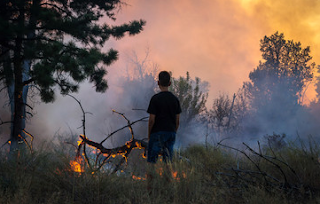Picture this...
10:07 am - John Monitor notices smoke in the forest behind his house.
10:10 am - John walks into the forest and sees fire, about 5 feet long and 3 feet wide. He snaps a picture on his phone and goes back inside.
 10:20 am - John goes back into the forest and sees the fire, which has gotten a little bit larger and snaps another picture of it. He even tells the fire, "You are getting bigger. You shouldn't do that." Then he goes back inside.
10:20 am - John goes back into the forest and sees the fire, which has gotten a little bit larger and snaps another picture of it. He even tells the fire, "You are getting bigger. You shouldn't do that." Then he goes back inside.10:45 am - John goes back to the fire and sees that it's about 15 feet by 5 feet. In awe, he uses his phone to take a video and tells the fire once again how big it is and that it really needs to snuff itself out.
11:00 am - The fire is in John's backyard. John records the fire, providing of a narrative of what is happening and why it should stop spreading.
Now Consider This ...
This scenario reminds me of what happens when campus and district leaders spend so much time monitoring that very little time is left for supporting teachers in acquiring the skills that are being monitored. When it's on paper like this, it seems like a no-brainer, but I know of school organizations that require administrators to complete 25 walk throughs per week. 25 walk-throughs, with no expectation of coaching beyond giving written feedback!
Most of the educational leaders I know really do want to be a real support for their teachers,and most do have the pedagogical and content knowledge to do so. So what's holding them back from helping their teachers from point A to point B? Possible barriers might be:
- time constraints
- an uncertainty of how to coach
- assuming that teachers know HOW to get to the desired behavior
- thinking that one-way, written feedback is enough to guide the teacher to the next level of effectiveness
I've noticed that organizations that over-monitor and under-coach, teachers feel a lack of support, they feel as though the leadership doesn't value them as professionals, and they question whether the leaders themselves know HOW to use the strategies that are being monitored. Unfortunately, this sometimes results in a low morale and high turnover rates.
Now imagine that you were in the classroom teaching right now and your campus leader watched your class for 15 minutes then left you this feedback:
I don't know about you, but I would be glad that someone noticed my kids are amazing during transition and get on task quickly. Then I would very quickly be thinking things like -
- Um, yes, I do already differentiate by offering 2 different activities in each station. Do we have different definitions of differentiation? What does it mean to you?
- Is this a campus expectation or did you think some of the tasks weren't appropriate for some kids. If so, which ones? I need to know.
- What are some other ways of differentiating stations? I'm not sure.
- How do I manage differentiated stations? How do I not alienate some children?
Now, the content of the feedback could be very valuable AND the teacher's thinking may be jogged. But if she has the same questions and wonderings as I did, she needs support beyond that walk-through form...she needs coaching!
If leaders were able to do fewer walk-throughs but connect coaching to the walk throughs they do complete, it would be like John Monitor calling 911, trying to throw dirt or water on the fire, digging a trench around it, and warning the neighbors to leave the area. It would be doing work to remedy the situation instead of continuing to monitor it.
Don't get me wrong - we must collect data to help inform our work with individual teachers, teams, and even decision making around curriculum and special programming. However, we have so much potential of growing our professional teachers by engaging in coaching conversations and by supporting the teacher through the process. Side-by-side support might look like co-planning, co-teaching, role-playing, or targeted/focused observations with a debrief. With any of those options, the leader is taking the teacher from where she currently is and bringing her one step closer to the expectation of where she should be. It means that we are working within the teacher's Zone of Proximal development, which is something we wouldn't even be able to identify if we were to only leave written one-way feedback.
When we commit to working alongside teachers during their learning and implementation phases, we are communicating that we are totally invested in their growth and success. If we were to commit to teachers' growth by doing fewer learning walks and more coaching, just imagine how supported would teachers feel. What a wonderful way to build relationship! And we know that building relationships, one person at a time, is how a healthy campus/district culture is created!
Time for self-reflection. If you are a campus are district leader stop and evaluate how your time is spent. Are you currently spending more time on reporting the fires or taking actions based on what you saw through coaching? If you are out of balance, what step can you take this week to get back to center?




Comments
Post a Comment